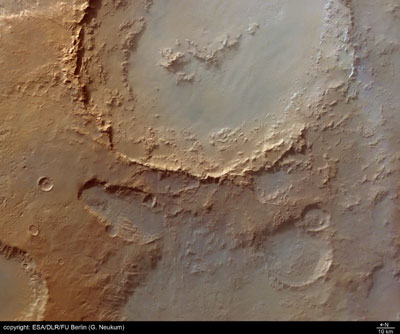Hale Crater is located in the Argyre Basin in the southern hemisphere of Mars. The wind and water eroded the crater and its surroundings. At the bottom of a photo taken by the European Mars Express you can see water flow channels

In the image, taken by the High Resolution Stereoscopic Camera (HRSC) on board the European Mars Express spacecraft, you can see the Hale Crater located in the Argyre Basin in the southern hemisphere of Mars. The image shows the area near the northern shore of the Argir Basin, located at latitude 36 south and longitude 324 east, and was taken at a resolution where each pixel is more or less equal to 40 meters during the 533rd lap of the Mars Express in June 2004. The image has only just been published. , towards the end of November. The cyclical colors and brightness differences in parts of the image indicate atmospheric disturbances and clouds.
Hale Crater, which has terraced walls, a central peak and part of the peripheral ring is visible in the upper (western) part of the image. The area was eroded due to ash that was thrown due to the collision and the processes that followed it.

A map showing the location of the crater
On the southern bank of Hale, part of the crater wall was shifted and fell towards the center of the crater. At the bottom of the image (the western part), a network of river channels caused by flowing water can be seen on the surface.
The HRSC experiment on the European Space Agency's Mars Express spacecraft is led by chief scientist Prof. Gerhard Neukum of the Free University of Berlin, who also designed the camera. The scientific team of the experiment includes 45 scientists from 32 institutions in 10 countries.
